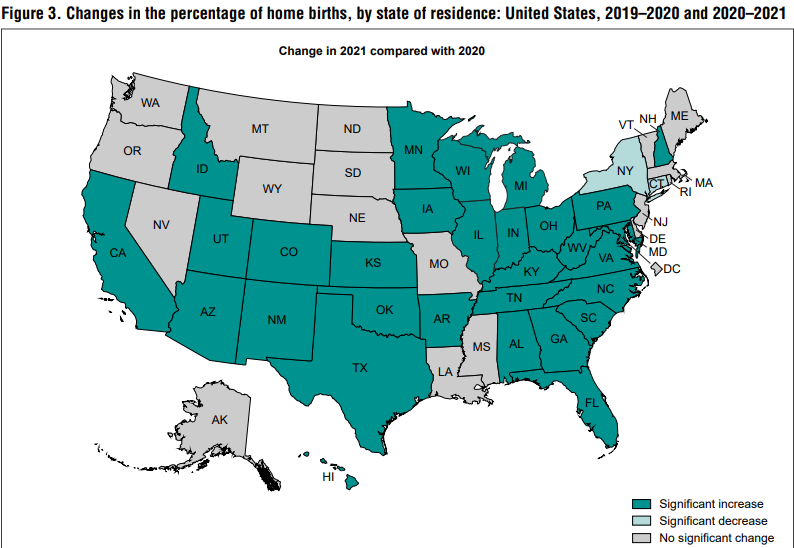The percentage of individuals giving birth at home rose to a 30-year high in 2021 thanks to the desire of those in labor to avoid hospitals swamped with COVID-19 patients and the accompanying danger of infection that might result.
Nearly 52,000 home births occurred last year, according to a report (PDF) issued yesterday by the Centers for Disease Control and Prevention (CDC). Most insurers and employers who self-fund insurance currently do not provide coverage for home births. Whether the CDC data collected during the COVID-19 pandemic change their minds remains to be seen.
The American College of Obstetricians and Gynecologists (ACOG), meanwhile, stands by its recommendation that the safest places to give birth are at hospitals or accredited birth centers.
“It is incumbent on us as medical professionals and those who manage medical facilities to make hospitals as safe and as welcoming as possible for all of our patients, especially those from communities of color,” Jeffrey Ecker, M.D., a former chairperson of ACOG’s committee on obstetric practice and chief of obstetrics and gynecology at Massachusetts General Hospital, told Fierce Healthcare.
The American College of Nurse-Midwives did not respond to a request for comment.
According to the CDC report, the percentage of home births increased by 30% from 2019 to 2020. From 2020 to 2021, the percentage of home births among all births rose from 1.26% (45,646) to 1.41% (51,642). That increase of 12% represents the highest level since at least 1990. The peak month for births at home was January 2021, at 1.51%.
“The 12% increase in home births from 2020 to 2021 follows a 22% increase from 2019 to 2020, with increases by maternal race and Hispanic origin ranging from 21% to 36%,” the report states. “Home births increased for 40 states, with nonsignificant increases seen for 9 additional states and D.C. from 2019 to 2020.”
CDC researchers reviewed birth information collected by the National Vital Statistics System, which contains 100% of births registered in the U.S. in five venue categories: hospital, home birth, free-standing birth center, clinic/doctor’s office and other.
The percentage of home births increased in 30 states from 2020 to 2021, ranging from 8% in Florida to 49% in West Virginia. In 11 other states, the increases were not significant, and in two states—Connecticut and New York—home births declined by 17% and 5%, respectively. Declines that were not significant occurred in seven other states and Washington, D.C.
From 2019 to 2020, the percentage of home births increased in 40 states, ranging from 11% to 68%. In that period, nonsignificant increases were seen in nine other states and Washington, D.C.

Ecker told Fierce Healthcare that the CDC’s “data does not allow us to pinpoint exactly what is driving this increase. Possible drivers of this increase could be related to the COVID-19 pandemic, distances to delivery centers especially in rural maternity care deserts, or pregnant individuals’ concerns about disparities in racial and ethnic maternal mortality and morbidity.”
Ecker reiterates that hospitals and accredited birth centers are the safest places to give birth in the statistically rare event that complications arise because of labor and delivery. Such complications can be “catastrophic,” said Ecker.
“Patients and providers should discuss individual factors that can impact the risk and outcome of childbirth so that they can make informed decisions about delivery plans, including their choice about where to deliver,” said Ecker.
ACOG issued a study written by its committee on obstetric practice in 2016 and which it reaffirmed in 2020 that notes the dangers of home birth in the category of trial of labor after cesarean delivery (TOLAC). It states that “because of the risks associated with TOLAC, and specifically considering that uterine rupture and other complications may be unpredictable, the College recommends that TOLAC be undertaken in facilities with trained staff and the ability to begin an emergency cesarean delivery within a time interval that best incorporates maternal and fetal risks and benefits with the provision of emergency care.”
Depending on location and other circumstances, home births cost much less than hospital births, according to a 2021 study in the International Journal of Environmental Research and Public Health.
The study found that home births cost, on average, $4,650. Meanwhile, births at hospitals average $18,865, according to Health System Tracker, operated by the Kaiser Family Foundation and the Peterson Center on Healthcare.
The International Journal of Environmental Research and Public Health study argues that “with the cost of birth spread across public assistance programs, employer-funded insurers, family-funded insurers and families paying out-of-pocket, the 65.7% lower cost of home births relative to hospital births represents an opportunity for substantial savings for governments, employers, insurance providers, and households. Changes in legislation, corporate policies, and attitudes regarding out-of-hospital births could reduce the health care burden in the United States by several billion dollars annually.”